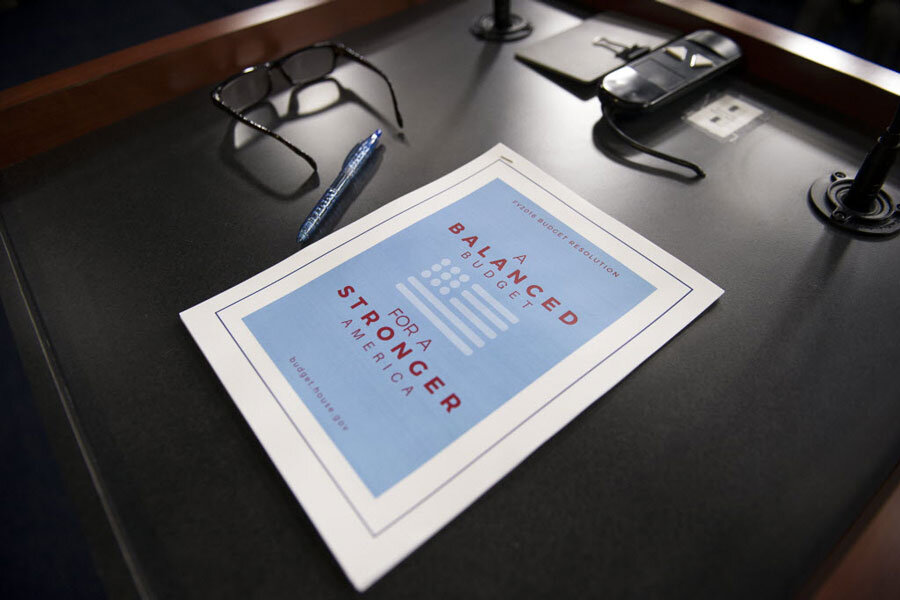Partisan divide over deficits: Is balanced budget the right goal?
| Washington
A centerpiece of new Republican plans in the House and Senate is to get revenues and spending into balance within a decade or less.
Democrats disagree with the premise of those plans. President Obama’s budget calls for a deficit of not zero but $687 billion deficit in 2025.
Actually, $801 billion is the likely 2025 deficit under Mr. Obama’s plan, when the estimates are done not by the White House but by the nonpartisan Congressional Budget Office.
Either way, the gap between a budget deficit of zero and one equal to about 2.5 percent of the economy’s annual output is a sizable one. The difference symbolizes competing visions on the role of government in America’s economic life.
So it’s useful to ask: Is a balanced budget the right overall target?
There’s no simple answer. There’s nothing magic about a balanced budget in general, but America really does have fiscal challenges that call for debt-reduction efforts.
Really, the underlying debate is less about whether to balance the budget than about the overall size of government. Democrats argue that a more expansive government, with higher taxes, can yield a growing economy whose fruits are widely shared by lower- and middle-income families. Republicans argue that a leaner government and lower taxes can deliver stronger growth that will help all Americans, not just the rich.
Opinion polls, meanwhile, suggest that many Americans lie between the partisan extremes. Nearly two-thirds called “reducing the budget deficit” a top priority for Washington in a January Pew Research Center poll. But polls also find high concern about bettering conditions for the poor (a top priority for 55 percent in the Pew poll) and support for actions (like raising taxes on the wealthy) to reduce the rich-poor gap.
And the recent Pew poll found strong support for addressing the projected insolvency of Social Security and Medicare – popular programs that in the past have required bipartisan compromise to reform.
“People do not believe that there’s really a free lunch,” without hard tradeoffs between taxes and government services, Bill White, the Democratic former mayor of Houston, said Wednesday at the conservative Heritage Foundation in Washington.
Still, it’s a myth that America cannot balance the federal budget without hurting the economy, Mr. White argues in his book, “America’s Fiscal Constitution.”
A nation can achieve strong economic growth without necessarily balancing its budget. But White’s research found that America’s story of economic success for 200 years was, in no small measure, rooted in a careful watch against too much debt.
In fact, what many economists say would be harmful is to do nothing about a high and rising national debt.
In a 2013 survey of about three dozen prominent US economists, the vast majority agreed with the statement that “countries that let their debt loads get high risk losing control of their own fiscal sustainability,” as creditors become wary about lending.
It’s not clear where the tipping point would be for America, which currently enjoys strong demand for its Treasury bonds.
But the national debt is historically high, at about 74 percent of one year’s gross domestic product (GDP).
“Under current law, debt would exceed 100 percent of GDP 25 years from now and would continue on an upward trajectory thereafter — a trend that could not be sustained,” the CBO has warned.
To many economists, lower debt levels could help the economy have some fiscal space to address future needs, from baby boomer retirements to a potential war or fiscal crisis.
Obama’s budget envisions holding the debt relatively stable over the next decade, carving it down to 73 percent of GDP in 2025.
House Republicans, in their new budget, call for the debt to fall to 55 percent of GDP by 2025 – progress achieved by restraining the growth of debt relative to GDP growth.
For reference, public debt stayed below 40 percent of GDP for most of the period between 1960 and 2008.
Of course, while the idea of debt reduction may sound great, those gains don’t come in the form of a free lunch. Congressional Democrats say the Republican budget would result in severe spending cuts for programs that millions of Americans rely on as a safety net in hard times
And Democrats attack the House Republicans’ Medicare-reform proposal as a voucher system that will undercut health-care security for millions of seniors.
Republicans may argue about those characterizations, but the critique hints at how any effort at balanced budgets would involve harrowing political fights over Medicare and other big federal programs.
For now, two very different visions have emerged for public debate.
The Obama plan, by the CBO’s estimates, would involve $49.5 trillion in federal spending over the next 10 years, and $6 trillion in deficits.
The Republican plans call for federal spending to be some $6 trillion less than that, and with deficits totaling about one-fourth of the Obama figure for the decade.
Republicans argue their plan doesn’t overdo the austerity. “Increasing spending by 3.3 percent [a year] instead of 5.1 percent is hardly draconian,” asserts a fact sheet from the House Budget Committee, chaired by Rep. Tom Price of Georgia.
The ranking Democrat on the committee, Chris Van Hollen of Maryland, says the Republican tax-reform ideas would boost the wealthy while their spending cuts would erode public investments (in things like education) that benefit the middle class and the whole economy.
“This budget takes away the tools that allow people to climb the ladder of opportunity,” he argued in a statement Tuesday.







